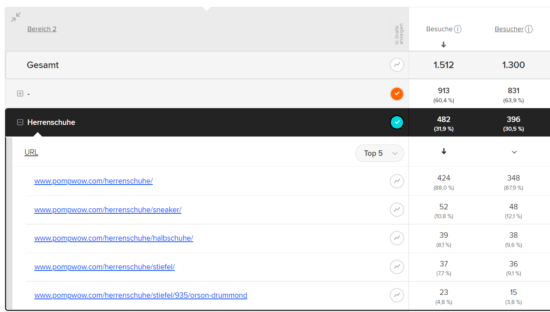Correctly interpreting clear key figures

by Katrin Nebermann
Correctly interpreting clear key figures
The total number of visitors (also referred to as “users” or “unique users”) and visits (also referred to as “sessions”) causes confusion from time to time. The reason for this is that the total number shown in the reports often does not match the sum of the individual values.
Why is that?
This is because several pages can be called up in one visit or by one visitor. This can be compared to a department store with several departments. If all customers entering the department store are counted at the entrance and in each department, it is very likely that the total number of customers per department is higher than the total number of accesses counted at the entrance. This is because a customer can visit several departments during their visit to a department store.
In this example too, the sum of the individual values for the “Men’s shoes” area is far higher than the unique total number:

The number of visitors should also be viewed with caution, as it depends on the technical limitations of visitor recognition. In order to recognize a visitor on subsequent days, it is necessary, among other things, that
- the cookie activation is used by etracker and is correctly linked to consent management.
- visitors consent to the setting of statistical cookies.
- the cookie has not been blocked, deleted or the runtime changed by means of browser settings (see https://www.cookiestatus.com/) or “ad blocker”.
The number of visitors in the reports accurately reflects the technically determinable number. The calculated number of visitors based on visitors with activated cookies is extrapolated, but is likely to be closer to reality. The calculated number of visitors is calculated as follows:
Number of (all) visits / frequency of visits (based on visitors with cookies) = calculated number of visitors

In our example, this results in
1,739 visits / 1.42 visits per visitor = 1,225 visitors
(presumably because they were extrapolated) could not be technically recognized, but had actually already visited the website during the period.
You should carefully consider whether you want to work with this additional imputed number of visitors in reporting. As an analyst, it is important to keep an eye on the technical conditions when the number of visitors changes over time. Currently, the consent dialogs on many websites need to be adapted on the basis of the new guidance from the supervisory authorities, namely with an equivalent opt-out option at the highest level. This naturally has an impact on the consent rate and thus the recognition rate of visitors.
The focus of KPI monitoring should be on the key figures “visits” and “number” in relation to conversions, which are independent of consent in the recommended consent-free or hybrid tracking.


